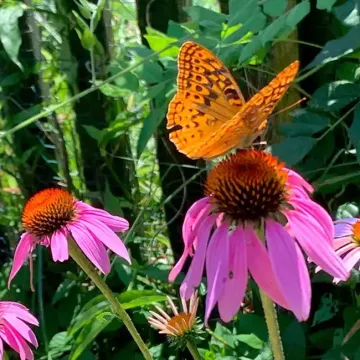A butterfly garden can bring vibrant beauty and essential pollinators to your yard. By selecting the right flowers, designing a thoughtful layout, and providing host plants, you can build a thriving haven for butterflies. Here’s a guide to help you get started.
Top Butterfly-Attracting Flowers
Butterflies are drawn to bright, nectar-rich flowers, especially those with flat-topped or clustered blooms that offer an accessible landing space. Here are some of the top flowers to include:
- Milkweed (Asclepias spp.) – Essential for monarch butterflies as a nectar source and host plant.
- Coneflowers (Echinacea spp.) – Durable and long-blooming, attracting various butterflies.
- Lantana (Lantana camara) – Colorful clusters of flowers that attract a wide range of butterflies.
- Butterfly Bush (Buddleja spp.) – As the name suggests, it's a magnet for butterflies.
- Black-Eyed Susan (Rudbeckia spp.) – Bright yellow flowers with an easy nectar source.
- Zinnias (Zinnia spp.) – A favorite for many butterflies, with various colors and bloom sizes.
- Joe Pye Weed (Eutrochium spp.) – A tall perennial that provides shelter to nectar and butterflies.
- Phlox (Phlox spp.) – Its rich nectar and sweet scent attract many species of butterflies.
- Asters (Symphyotrichum spp.) – Late-season bloomers that provide nectar when other plants have stopped flowering.
- Verbena (Verbena bonariensis) – Its long stems and clusters of tiny flowers are ideal for butterflies.
Common Butterflies and Their Host Plants
Different butterfly species need specific host plants where they lay their eggs and feed their larvae (caterpillars). Including these plants is essential for building a sustainable butterfly habitat.
- Monarch Butterfly
- Host Plant: Milkweed (Asclepias spp.)
- Nectar Plants: Butterfly bush, zinnias, coneflowers
- Swallowtail Butterfly
- Host Plant: Parsley, dill, fennel, and carrots
- Nectar Plants: Phlox, aster, lantana
- Painted Lady Butterfly
- Host Plant: Thistles, hollyhocks, and sunflowers
- Nectar Plants: Aster, verbena, zinnias
- Black Swallowtail
- Host Plant: Dill, fennel, parsley
- Nectar Plants: Joe Pye weed, coneflowers, phlox
- Red Admiral
- Host Plant: Nettles
- Nectar Plants: Butterfly bush, lantana, milkweed
- Gulf Fritillary
- Host Plant: Passionflower
- Nectar Plants: Lantana, zinnias, verbena
Layout Strategies for a Butterfly Garden
- Sunlight is Key: Butterflies love warmth, so position your garden in an area with at least 6 hours of sunlight daily. Plant taller species in the back and shorter, ground-covering plants in the front for optimal sun exposure.
- Group Flowers by Color: Butterflies are attracted to masses of bright, single-color flowers. Group plants of the same color together to create large blocks of vibrant blooms that are easy for butterflies to spot.
- Layered Heights: To mimic nature, design your garden with plants of varying heights. Taller nectar-rich plants like Joe Pye Weed can serve as windbreaks while lower-growing flowers like coneflowers and phlox fill in gaps.
- Provide Shelter: Incorporate bushes, tall grasses, and even stone walls to protect butterflies from strong winds and predators and give them places to roost at night.
- Create a Butterfly Oasis: Butterflies need water but prefer shallow water. Provide a shallow dish with pebbles or sand for butterflies to land on while drinking. Alternatively, keep moist sand or mud in the garden to create a “puddling” station, which provides essential minerals for butterflies.
Tips for a Successful Butterfly Garden
- Choose Native Plants: Native plants are adapted to your region’s climate and soil, making them better for local butterflies. They also require less water and maintenance.
- Go Organic: Avoid using pesticides and herbicides in your garden. These chemicals are harmful to butterflies at all stages of life.
- Plant in Succession: Both annuals and perennials have species that bloom at different times of the year. Knowing when they bloom will help you plan a continuous source of pollen and nectar for pollinators.
- Provide Host Plants: In addition to nectar-rich flowers, plant host plants where butterflies can lay their eggs. Without these, caterpillars won’t have the food they need to develop.
- Add a Rock or Two: Butterflies enjoy basking in the sun to warm up. Flat rocks placed in sunny areas can serve as butterfly “lounges.”
By following these strategies and tips, your butterfly garden will be a flourishing habitat that brings beauty to your yard and supports the essential life cycle of these important pollinators.

